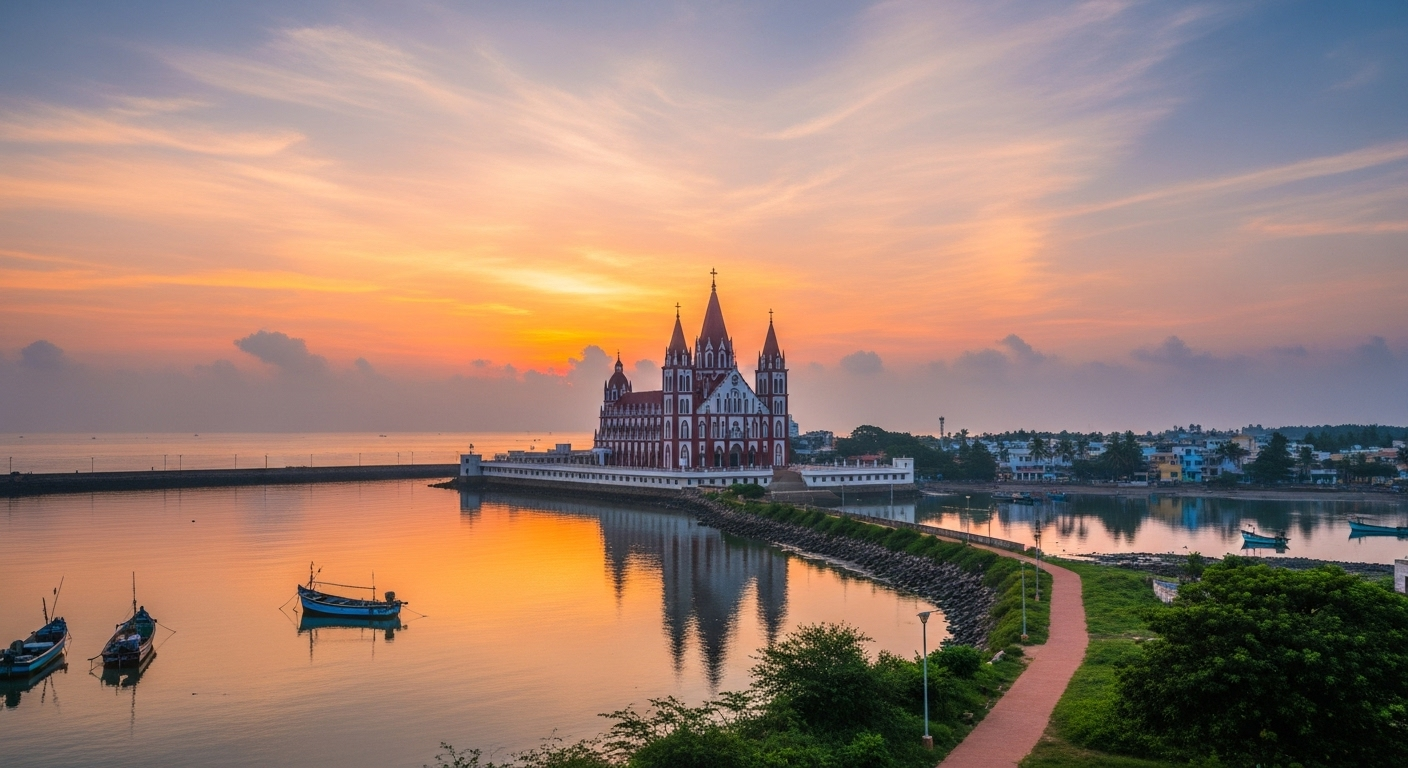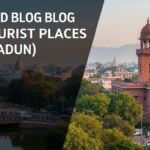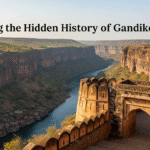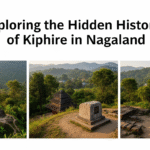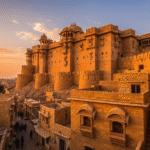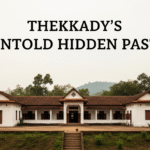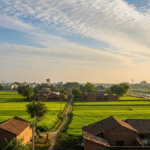In the small town of Velankanni, in Tamil Nadu, millions of pilgrims come each year. This place is called the ‘Lourdes of the East.’ It has a secret past full of amazing stories and deep faith. Velankanni’s history is not just about a famous shrine. It also includes a mix of cultures, beautiful buildings, and stories from many dynasties.
Velankanni is unique, not like the temples of Hyderabad. Its charm comes not only from faith but from its long history. This history shows how different cultures came together. Over centuries, Velankanni became a place of both spiritual and architectural beauty. This place keeps its stories safe, no matter what changes come.
Key Takeaways
- Millions of visitors flock to the quaint town of Velankanni, revealing its status as a major pilgrimage site.
- The amalgamation of cultures and faiths in Velankanni has produced a history rich with diverse influences.
- Vilified myths and the spiritual journey through centuries showcase Velankanni’s complex development.
- Distinguished from popular misconceptions, Velankanni’s historical facts present a unique narrative independent of other Indian temples.
- Understanding the cultural significance of festivals, architecture, and the maritime heritage offers a deeper connection with Velankanni’s secret past.
Velankanni’s Origins and Mysterious Past
The quaint town of Velankanni is on Tamil Nadu’s Coromandel Coast. It has a rich history of Velankanni mysterious origins and stories. It is famous for its sacred Basilica. The shrine’s history is full of intriguing tales and divine interventions.
One key event that shows Velankanni’s sacredness happened in the 16th century. A merchant ship from Macao faced a deadly storm in the Bay of Bengal. The sailors prayed to the Virgin Mary for safety, promising to build a church for her. The storm calmed, and they safely reached Velankanni. This miracle is a crucial story of Velankanni unknown stories. It led to the Basilica’s creation, a big thank you to the divine.
Velankanni unknown stories tell of the Virgin Mary appearing many times. These visits are linked to miraculous healings. They helped make Velankanni the “Lourdes of the East.”
Every year, 15 to 20 million people visit Velankanni during the Notre Dame de la Santé festival. This event lasts ten days, starting on August 29. It brings together devout people and travelers. They are drawn by tales of miracles and the peaceful sanctuary.
The Basilica has mosaic tiles showing bible stories. These tiles honor the grateful sailors. They add to Velankanni’s beauty. They remind us of the town’s connections to the sea and the Virgin Mary’s miracles.
| Event | Date/Period | Description |
|---|---|---|
| Shipwreck Salvage | 16th Century | A merchant ship from Macao was saved from a storm in the Bay of Bengal after sailors promised to build a church in honor of the Virgin Mary. |
| Establishment of the Basilica | Post-16th Century Miracle | A church was built, evolving into the modern-day Basilica, signifying the location of the maritime miracle. |
| Annual Festival | August 29 – Ten days | The Feast of Notre Dame de la Santé draws approximately 15 to 20 million visitors, celebrating the fabled origins and history of Velankanni. |
At the center of Velankanni’s stories is how it mixes church history with local tales. This creates a unique spiritual story. Millions are drawn to its mystery and charm. The true allure of Velankanni lies in its grand Basilica. But also in its tales of faith, overcoming, and deep devotion from its past.
Uncovering Velankanni’s Hidden Past
We’re on a quest to discover Velankanni’s deep history. We learn about its early life and mysterious tales. These stories show us the town’s old spirit and culture.
Insights into the Early Settlements
We look back at how Velankanni started. It was big in trade because of its spot on the Coromandel Coast. It grew fast due to its good location. People found old items that show how early people lived.
Ancient Legends and Myths of Velankanni
Velankanni’s old stories are fascinating. One famous story is about Mother Mary appearing in the 16th century. She brought miracles, starting the town’s spiritual path. This tale adds a magical touch to Velankanni.
We find more stories as we dig deeper. Many are about miracles and holy sightings. The Basilica of Our Lady of Good Health shows this faith. It stands for years of belief and love.
Learning about Velankanni’s past is exciting. We see how trade, faith, and stories mix together. Velankanni’s history is a mix of work, belief, and legend. It makes us want to learn more.
The Spiritual Heritage of Velankanni
The town of Velankanni is known as the “Lourdes of the East.” It has a strong spiritual history. People from all over the world come here. The sacred traditions of Velankanni have been passed down through many years.
At the center of religious life here is the Basilica of Our Lady of Good Health. This place is known for its beautiful Gothic-style architecture. It gives spiritual peace to those who visit. The story of the Marian apparitions that happened long ago is still told today. It makes the visit even more special.
Velankanni has a big feast every year on September 8. It celebrates the birth of the Virgin Mary. Lots of pilgrims come to join. The feast shows the town’s religious importance and its rich culture.
Every part of Velankanni has its own faith story. There are many small shrines and the Feast of the Nativity of Mary. All these add to the town’s holy history.
Velankanni’s spiritual story is not just about places and events. It’s also about the hope and faith they stand for. This spiritual path has touched many hearts. It continues to bring peace and blessings to those who come to Velankanni.
Chronicles of Velankanni: From a Local Hamlet to a Center of Worship
The serene town of Velankanni has changed a lot. It went from a simple fishing village to a busy place of worship. This big change was helped by its history and culture, including the dynastic influence on Velankanni.
Tracing the Transformation Over Centuries
Velankanni started as a small coastal village long ago. It grew into a big place for Christian pilgrims from all over. This growth saw the building of big churches, showing how important religious places are in India.
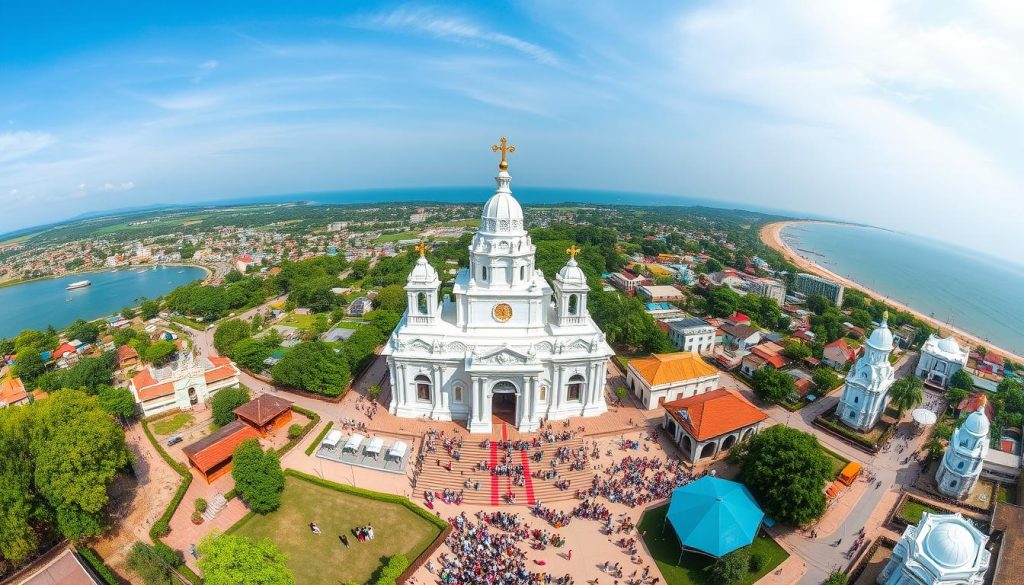
The Role of Dynasties in Shaping Velankanni
The local and regional dynasties really shaped Velankanni’s religious setting. These dynasties loved architecture and art. They built beautiful churches and places for people to meet. This helped spread Christian values in the local culture.
They also helped everyone in the community come together. This mix of culture and religion made Velankanni’s life richer.
To learn more about how changes like these happen worldwide, check out Velankanni’s transformation. It gives a bigger picture of how changes improve traditions and places.
Architecture and Art: Symbols of Velankanni’s Hidden History
Velankanni’s architectural heritage and art show its culture and history. Ancient buildings and art tell stories of Velankanni’s past. They show how religion and society changed over time.
Velankanni’s buildings combine Indian styles with foreign influences. This mix comes from its history with colonizers and traders. It’s a blend of cultures, showing in its art and architecture.
| Element | Influence | Description |
|---|---|---|
| Church Architecture | Portuguese Colonial | Elegant spires and intricate altars infused with local artistry, adapting European styles to local tastes and climates. |
| Temple Structures | Dravidian Influence | Robust and ornately carved gopurams (gateway towers) that speak volumes about the region’s deep-rooted Hindu traditions. |
| Public Art | Local Craftsmanship | Statues and murals throughout the town depict religious and historical scenes, heavily influenced by regional folklore and crafted by local artisans. |
Velankanni’s architectural heritage tells spiritual stories, too. Each building and mural shares tales from Velankanni’s history. These stories have evolved over time. As India celebrates its culture, Velankanni highlights the mix of history, art, and architecture. It helps us understand our social identities today.
The Role of Maritime Trade in Velankanni’s Development
The quaint town of Velankanni is well-known for its spirituality. But its history in maritime trade and the Portuguese influence are also key to its culture and economy. Located on the Coromandel Coast of Tamil Nadu, Velankanni was important in old trade routes. This brought many different influences to the town.
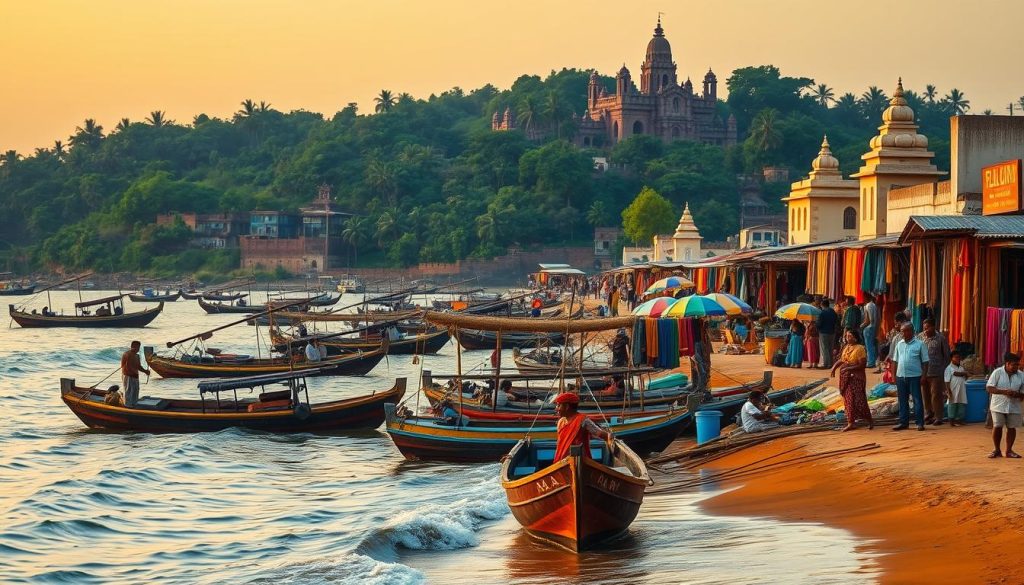
Influence of Portuguese Traders on the Town’s Identity
Portuguese traders changed Velankanni a lot when they came for business. They influenced the town’s buildings and its spiritual life. You can see the Portuguese impact in Velankanni’s baroque style churches. They look like those in Lisbon. This shows a mix of local traditions with colonial history.
Velankanni’s Position on Historic Trade Routes
Velankanni was an important maritime hub on India’s east coast. This position allowed it to thrive from trade with East Asia, the Middle East, and Europe. The trade was not just in goods but also in ideas and beliefs. This created a unique culture that is still seen in the area today.
| Historic Influence | Impact on Velankanni |
|---|---|
| Portuguese Architecture | Introduction of Gothic revival and baroque architectural styles in local churches. |
| Economic Trade | Boosted local economy through trade in spices, silk, and precious stones. |
| Cultural Exchange | Integration of European customs with local traditions. |
| Spiritual Interactions | Introduction of Christianity leading to religious syncretism. |
| Technological Exchange | Introduction of advanced maritime navigation and shipbuilding techniques. |
The history of Velankanni’s maritime trade and Portuguese influence is very important. It helps us understand how the town became what it is today. Learning about the trades and cultures of the past shows the value of maritime activities in Velankanni’s growth.
Vestiges of Colonial Impact on Velankanni
Exploring Velankanni’s history shows a mix of cultures from European rulers. This blend is seen in the town’s buildings, society, and governance.
European powers changed Velankanni a lot during their time. They brought new building styles, laws, and culture. Today, we see European designs in local buildings, mixed with Indian styles.
This blend in architecture shows Velankanni’s deep history. Churches and homes have marks of foreign rule. This mix is both beautiful and meaningful.
Colonial times also changed Velankanni’s government. European ways started to mix with local customs. This was hard at first. But it led to new systems that we still use today.
| Aspect | Pre-Colonial | Colonial Influence | Modern Adaptations |
|---|---|---|---|
| Architecture | Indigenous Dravidian styles | Incorporation of Gothic and Victorian elements | Hybrid architectural preferences in public and religious buildings |
| Governance | Local chieftain-led administration | Implementation of European legal and administrative systems | Democratic governance with residuals of European systems |
| Cultural Practices | Traditional Tamil festivals and rituals | Introduction of Western clothing and education | Synthesis of European and local traditions |
Velankanni’s culture is unique because of its history. Looking at its past, we see a town shaped by many influences. This makes Velankanni today very special.
Religious Syncretism: The Fusion of Beliefs in Velankanni
The coastal town of Velankanni, Tamil Nadu, India, is a mix of cultures and faiths. It’s where beliefs blend together, creating a community like no other. We’ll explore how Hindu and Christian traditions mix in Velankanni, making it special.
Integration of Hindu and Christian Practices
In Velankanni, Hindu and Christian faiths merge into one faith. People are drawn to its unique way of worship, combining rituals from both religions. This shows India’s love for religious peace and adaptability, giving Velankanni a unique identity.
Velankanni’s Unique Celebrations and Rituals
Velankanni’s year is full of special festivals that mix Christian and Hindu ways. There are Christian processions and Hindu traditions, showing Velankanni’s mixed faith. Visitors see the blend of beliefs, making Velankanni a place of unity and shared spirituality.
FAQ
What are some lesser-known historical facts about Velankanni?
Velankanni is known for its shrine, the Basilica of Our Lady of Good Health. This place is special because the Virgin Mary is said to have appeared here in the 16th century. This event is key to the town’s spiritual life. The town’s early history isn’t well-known, leading to many legends.
What ancient legends and myths are associated with Velankanni?
Velankanni has tales about the Virgin Mary appearances. In one story, she appeared to a Hindu boy with Jesus, and performed a miracle. Another tale talks about a Portuguese ship saved from a storm by praying to the Virgin Mary.
How did Velankanni grow from a local hamlet to a center of worship?
Velankanni changed from a small village to a famous place because of the Virgin Mary’s apparitions. These events led to building a big basilica. Now, many pilgrims visit, making the town important.
What impact did various dynasties have on Velankanni?
Different dynasties have left their mark on Velankanni, but their exact roles aren’t fully known. The town shows a mix of local ruler influences and cultural practices from over time.
How does the architecture in Velankanni represent its hidden history?
The Basilica of Our Lady of Good Health is a key architectural site in Velankanni. It shows Gothic styles. The buildings in town tell the history through their designs, showing Indian and European influences.
What was the role of maritime trade in the development of Velankanni?
Maritime trade was important for Velankanni’s growth. It helped the economy and brought cultures together. The town became a hub because of its port. Portuguese traders had a big role in this.
How did Portuguese traders influence Velankanni’s identity?
Portuguese traders helped spread Christianity in Velankanni. You can see their impact in the style of the churches and local customs. Their influence mixed with local traditions, creating a unique culture.
What are some remnants of the colonial era visible in Velankanni today?
The colonial era’s effects are seen in Velankanni’s religious practices and language. English is spoken by many. The Basilica is a big sign of this era, built during European colonial times.
How does religious syncretism manifest in Velankanni?
Velankanni shows religious syncretism by mixing Catholic and Hindu traditions. Catholics join in Hindu festivals, and Hindus do the same, showing a culture of tolerance. The shrine’s design also blends both religious styles.
Can you describe some unique celebrations and rituals specific to Velankanni?
A special event is the September 8th feast of Our Lady of Good Health. It brings together people from different backgrounds. The celebration includes processions, a nine-day Novena, and a car procession, showing unity in religious practices.
